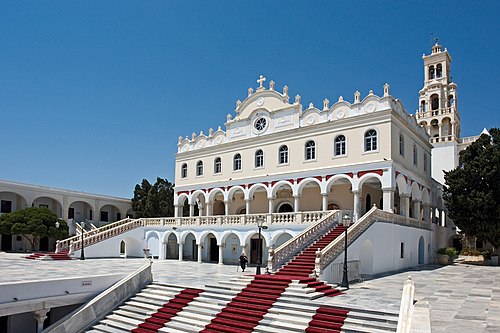Top Qs
Timeline
Chat
Perspective
January 30 (Eastern Orthodox liturgics)
Day in the Eastern Orthodox liturgical calendar From Wikipedia, the free encyclopedia
Remove ads
January 29 - Eastern Orthodox liturgical calendar - January 31

All fixed commemorations below are observed on February 12 by Eastern Orthodox Churches on the Old Calendar.[note 1]
For January 30th, Orthodox Churches on the Old Calendar commemorate the Saints listed on January 17.
Feasts
- Synaxis of the Three Holy Hierarchs:
- Saint Basil the Great, Saint Gregory the Theologian, and Saint John Chrysostom.[1][2][3][4]
Saints
- Hieromartyr Hippolytus, priest, of Antioch, martyred in the period of the heretical Novatianists.[5][note 2]
- Hieromartyr Hippolytus of Rome, Bishop of Rome, and those with him:
- Martyrs Censorinus, Sabinus, Ares (Aares), the virgin Chryse (Chryse of Rome), Felix, Maximus, Herculianus, Venerius, Styracius, Mennas, Commodus, Hermes, Maurus, Eusebius, Rusticus, Monagrius, Amandinus, Olympius, Cyprus, Theodore the Tribune, the priest Maximus, the deacon Archelaus, and the bishop Cyriacus, at Ostia,[1][3] – under Roman Emperor Claudius Gothicus and a vicarius named Ulpius Romulus (269)[7][8][note 3] (see also August 13 - Hippolytus of Rome - who may or may not be the same individual)
- Venerable Zeno the Hermit, of Antioch (414), disciple of St. Basil the Great.[1][10]
- Martyr Theophilus the New, in Cyprus (784)[1][3][11][12]
- Venerable Kyriakos, ascetic of the Great Lavra of St. Sabbas the Sanctified (7th-8th centuries)[13]
- Saint Peter I of Bulgaria, King of Bulgaria (969)[1][3][14][15]
Remove ads
Pre-Schism Western saints
- Saint Matthias of Jerusalem, bishops of Jerusalem, confessor (120)[16]
- Saint Martina of Rome, a martyr in Rome under Alexander Severus (228)[17]
- Saint Savina of Milan (Sabina), born in Milan, she ministered to martyrs in prison and buried their bodies during the persecution of Diocletian (311)[6][17]
- Saint Armentarius of Antibes, first Bishop of Antibes in Provence in France (ca. 451)[17][note 4]
- Martyrs Felician, Philippian and Companions, a group of one hundred and twenty-six martyrs in North Africa.[6][17][18]
- Saint Tudy (Tudclyd, Tybie), a virgin in Wales; St Tybie's church in Llandybie in Dyfed is named after her (5th century)[17]
- Saint Adelgonda (Adelgunda), foundress of Maubeuge Abbey (680)[1][6][17][note 5]
- Saint Balthildes (Bathilda), Queen of France (680)[1][17][19][note 6]
- Saint Armentarius of Pavia, Bishop of Pavia (ca. 711)[6][17]
- Saint Amnichad (Amnuchad), a monk and then a hermit at Fulda monastery (1043)[17]
Post-Schism Orthodox saints
- Venerable Zeno the Faster, of the Kiev Caves Monastery (14th century)[1][3][20][21][note 7]
- New Martyr Hadji Theodore of Mytilene (Mt. Athos) (1784)[1][22][23]
- New Martyr Demetrius of Sliven (1841)[1][24][25]
- Saint Theophil, fool-for-Christ, of Svyatogorsk Monastery (1868)[1]
- Blessed Pelagia of Diveyevo Monastery, fool-for-Christ (1884)[1][3][24][note 8]
New martyrs and confessors
Remove ads
Other commemorations
- Finding of the Wonderworking Icon of Panagia Evangelistria of Tinos (1823)[1][26][27][28][29] (see also: December 18)
- Commemoration of the deliverance of the island of Zakynthos from the plague by Saint George the Great-Martyr (1688)[30]
Icon gallery
- Synaxis of the Three Holy Hierarchs.
- Synaxis of the Three Holy Hierarchs.
- Seal of Bulgarian tsar Peter I.
- Relics of St. Savina of Milan, in Milan, Italy.
- A mediaeval depiction of St. Balthildes, Queen of France.
- St. Zeno the Faster, of the Kiev Caves Monastery.
- Shrine of Panagía Evangelístria of Tinos.
Notes
- The notation Old Style or (OS) is sometimes used to indicate a date in the Julian Calendar (which is used by churches on the "Old Calendar").
The notation New Style or (NS), indicates a date in the Revised Julian calendar (which is used by churches on the "New Calendar"). - "At Antioch, the passion of the blessed priest Hippolytus, who, for a short time deceived by the Novatian schismatics, was converted by the grace of Christ and returned to the unity of the Church, for which and in which he afterwards underwent a glorious martyrdom. Being asked by the schismatics which was the better side, he repudiated the doctrine of Novatus, and affirming that the faith ought to be professed which the Chair of Peter taught, he presented his neck to the executioners."[6]
- An old church is dedicated to him in Draguignan.
- Sister of St Waldetrudis, Abbess of Mons in Belgium. She founded the convent of Maubeuge in the north of France.
- Born in England, she was sold as a slave to the mayor of the palace of the Kingdom of Neustria. In 649 King Clovis II married her and she became the mother of three future kings. After her husband's death, she was regent of France (656-664). When Clotaire III came of age, she became a nun at the convent of Chelles which she had founded.
- See: (in Russian): Зинон Постник. Википедии. (Russian Wikipedia).
- See: (in Russian): Пелагия Дивеевская. Википедии. (Russian Wikipedia).
Remove ads
References
Sources
Wikiwand - on
Seamless Wikipedia browsing. On steroids.
Remove ads







